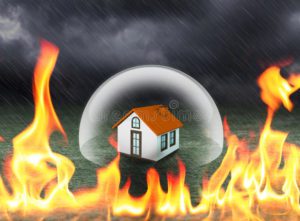Home insurance is required to protect your home from unexpected events. Your homeowner’s policy usually covers repairs in the event that your home is damaged by a fire. You may need separate wildfire insurance if you live in an area at high risk for fire damage.
Your homeowner’s insurance policy generally covers fire damage, including wildfires. If your home is damaged by a wildfire, your policy will typically cover the cost of rebuilding or repairing it. Insurance policies may also cover temporary housing costs, the replacement of your belongings and restoration of landscaping. The policy you choose and the risk of wildfires in your area can affect the extent and cost of coverage.
To find out your deductible, coverage details and other details regarding wildfire damage to your home, personal property and landscaping, such as trees and shrubs, check your policy.
The three main types of homeowner’s insurance coverage are dwelling coverage, personal property coverage, and coverage for other structures. Here are the possible coverages for fire damage if your policy covers dwelling coverage, coverage for other buildings, and personal property coverage.
Additional living expenses coverage may be available for those who are unable to live in their home because of wildfire damage. This coverage may cover expenses like a hotel stay or pet boarding, as well as restaurant bills and laundry services, depending on the policy. This coverage might also be applicable if you are required to evacuate by local authorities.
The coverage for additional living expenses is usually a percentage of your dwelling coverage. If your dwelling coverage is 25% and your living expenses coverage is $350,000, then you could have $87,500 to cover your living expenses due to loss of use. To understand the details of your policy regarding fire damage to your home or belongings, it is a good idea to review your policy.
Renters insurance protects against wildfires even if you live in high-risk areas. Your existing rental insurance will cover your personal possessions, living expenses, loss, and additional insurance.
Condo insurance will cover wildfire damage, just like renters insurance. Condo insurance does not cover damage to your condo’s “inside walls”. This is the main difference between condo insurance and a standard homeowners policy. Your exterior walls and property should be covered by the homeowners association’s insurance policy. It’s a good idea, however, to check what your HOA’s insurance policy covers, especially for those who live in an area that is prone to fire.
Although many homeowner’s policies provide coverage for fire damage and other damages, it may depend on the fire danger in your locality. Some insurance companies will increase deductibles or cap payouts for homes located in high-risk areas.
If your insurance company refuses to cover fire damage, you will need to buy a separate wildfire insurance plan. You may be able purchase wildfire insurance policies through a surplus carrier, premier carrier or the FAIR plan.
It’s crucial to know what your homeowner’s policy covers and if you will need wildfire insurance. This will ensure that you are adequately covered if you live in an area prone to fire. Preventing a fire is the best way to minimize any damage. You can fireproof your house by taking steps beyond purchasing the right insurance policy. You can prepare for this fire season in many ways, regardless of whether you live in an area with high fire danger or a dry climate.
Original Blog: https://www.redfin.com/blog/homeowners-insurance-in-fire-prone-areas/
